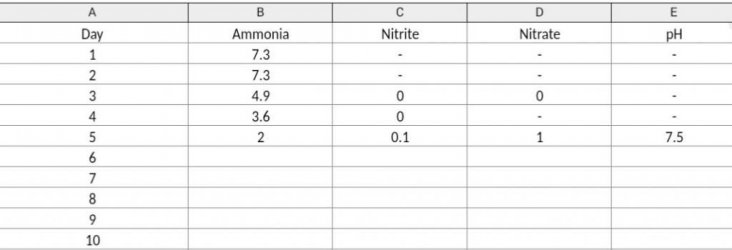I am a bit nervous about the numbers you report. Especially the lack of nitrite. Normally the bacteria live together in a biofilm along with a host of other beneficial bacteria. What makes this important is that in a cycled tank there is a proper balance between the ammonia and nitrite converting bacteria. This is how a tank turns ammonia straight to nitrate with no reading for them showing on our test kits. The point is when we seed a tank with items from an established than there should be a balance between the incoming bacteria such that the amount of ammonia it can process is balanced by and equal amount of nitrite converters.
The next part of this all is that, in the absence of plants which would also use the ammonia but not produce any nitrite from it, 1 ppm of ammonia can convert to 2.55 ppm if nitrite and finally 3.46 ppm of nitrate. Now even if your tank had a mysterious surplus of nitrite bacteria such that it could convert more nitrite than the ammonia ones can make, the end result is still nitrate. So if your 7.3 ppm is indeed a real reading, it means it will turn into 18.6 ppm of nitrite and finally to 25+ ppm of nitrate. Now look at your numbers and you will see why I am confused. Especially since the ammonia bacs reproduce noticeably faster than the nitrite ones.
What compounds this is the fact that as the ammonia notched down, we see no nitrite to speak of and a scant 1 ppm of nitrate. I know of no hobby kit on which it would be possible to get a 1 ppm reading. The human eyes are not that good at color perception to be able to discern such minute color shifts. Most kits start at 5 ppm or higher I believe. And even then their accuracy is notoriously poor compared to the other kits.
But even the behavior of the ammonia does not make sense. Ammonia itself in excess of 5 ppm doesn't stop the ammonia bacs from working, the danger is that the nitrite levels it produces will. However, the ammonia bacs you seeded would have been in good shape and able to work immediately. Yet in the 1st 24 hours you report a 0 drop while in the 2nd 24 the ammonia drops by 1/3 and this is also not possible. But it gets weirder. Consider that the longer the process lasts, the more ammonia bacs one has so the more ammonia they can process each day, and then look at your numbers:
Day 1- 7.3
Day 2- 7.3 change = 0
Day 3- 4.9 change = -2.4
Day 4- 3.6 change = -1.3
Day 5- 2.0 change = -1.6
Again this makes no sense. If the bacteria could convert 2.4 ppm on day 3 how can they not do so on days 4 and 5.
I would ask you to post:
1. Size of the tank.
2. Brand of dechlor.
3. Brand of test kits.
4. Strength of the ammonia used and the ml (not ppm) amount you added.
With that info I can offer you a simple way to proceed from here which will provide a better idea of where the tank may stand. My hunch is there is some bacteria at work, the numbers you reported are not correct and that a reset of the tank will show what may actually be up.


